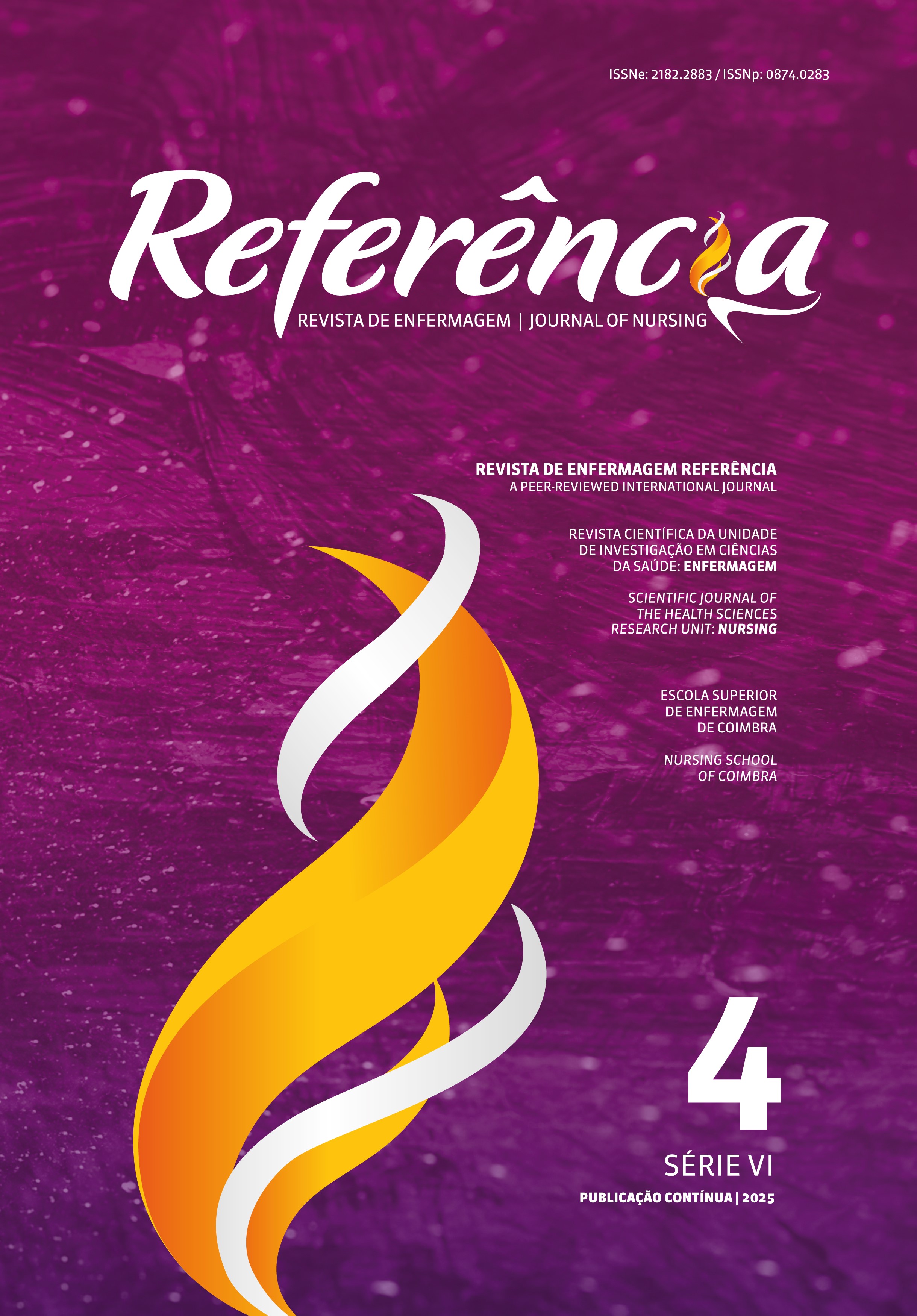Funcionalidade e aprendizagem de um dispositivo de reabilitação para doentes pós-enfarte: Perspetiva de enfermeiros de reabilitação
DOI:
https://doi.org/10.12707/RV21032Palavras-chave:
enfermagem em reabilitação, infarto do miocárdio, reabilitação cardíaca, projetos de desenvolvimento tecnológico e inovaçãoResumo
Enquadramento: A patologia cardiovascular constitui uma das principais causas de morte e incapacidade em Portugal. Para a promoção da recuperação funcional da pessoa, o desenvolvimento de dispositivos de reabilitação é uma prioridade importante.
Objetivos: Descrever dois protótipos do Ablefit a nível da funcionalidade e aprendizagem para doentes pós-enfarte.
Metodologia: Investigação qualitativa com recurso a grupos focais. Foram recrutados enfermeiros especialistas em reabilitação por amostragem de conveniência.
Resultados: Foram incluídos 16 participantes no estudo. Os protótipos são funcionalmente distintos, possibilitando o beta maior variação de resistência e introdução de progressão a nível do programa de exercícios. A função de biofeedback introduzida posteriormente permite adaptação do programa e facilita o regresso a casa. A cicloergometria para membros inferiores incluída no alfa é uma vantagem significativa e deverá ser melhorada.
Conclusão: O protótipo alfa apresenta menos características funcionais e facilidade de aprendizagem que o beta, sendo limitativo na modulação da resistência dos exercícios, bem como na incapacidade de monitorizar os parâmetros fisiológicos. Recomenda-se explorar a funcionalidade de biofeedback em futuros protótipos.
Downloads
Referências
Bardin, L. (2016). Análise de conteúdo. Almedina Brasil.
Brown, C. J., Peel, C., Bamman, M. M., & Allman, R. M. (2006). Exercise program implementation proves not feasible during acute care hospitalization. Journal of Rehabilitation Research & Development, 43(7), 939-946. https://doi.org/10.1682/jrrd.2006.04.0034
Brysiewicz, P., Hughes, T. L., & McCreary, L. L. (2015). Promoting innovation in global nursing practice. Rwanda Journal Series F: Medicine and Health Sciences, 2(2), 41-45. https://doi.org/10.4314/rj.v2i2.7F
Chau, K. Y., Lam, M. H., Cheung, M. L., Tso, E. K., Flint, S. W., Broom, D. R., Tse, G., & Lee, K. Y. (2019). Smart technology for healthcare: Exploring the antecendents of adoption intention of healthcare wearable technology. Health Psychology Research, 7(1), 33-39. https://doi.org/10.4081/hpr.2019.8099
Claes, J., Buys, R., Woods, C., Briggs, A., Geue, C., Aitken, M., Moyna, N., Moran, K., McCaffrey, N., Chouvarda, I., Walsh, D., Budts, W., Filos, D., Triantafyllidis, A., Maglaveras, N., & Cornelissen, V. (2017). PATHway I: Design and rationale for the investigation of the feasibility, clinical effectiveness and cost-effectiveness of a technology-enabled cardiac rehabilitation platform. BMJ Open, 7, e016781. https://doi.org/10.1136/bmjopen-2017-016781
Direção-Geral da Saúde. (2017). Programa Nacional para as Doenças Cérebro-Cardiovasculares. https://www.dgs.pt/ficheiros-de-upload-2013/aaaaaaaaaaa_pndccv-2017-temp-pdf.aspx
Giggins, O. M., Persson, U. M., & Caulfield, B. (2013). Biofeedback in rehabilitation. Journal of NeuroEngineering and Rehabilitation, 10(60). https://doi.org/10.1186/1743-0003-10-60
Jarvis, S., & Saman, S. (2017). Diagnosis, management and nursing care in acute coronary syndrome. Nursing Times [Online], 113(3), 31-15. https://www.nursingtimes.net/clinical-archive/cardiovascular-clinical-archive/diagnosis-management-and-nursing-care-in-acute-coronary-syndrome-13-02-2017/
Lara, J. S., Casas, J., Aguirre, A., Munera, M., Rincon-Roncancio, M., Irfan, B., Senft, E., Belpaemne, R., & Cifuentes, C. A. (2017, july 17-20). Human-robot sensor interface for cardiac rehabilitation. In F. Amirabdollahian, E. Burdet & L. Masi (Eds.), 2017 International Conference on Rehabilitation Robotics (ICORR), London, England (pp. 1013-1018). https://doi.org/10.1109/ICORR.2017.8009382
Lopes, J. S., Machado, A. F., Micheletti, J. K., Almeida, A. C., Cavina, A. P., & Pastre, C. M. (2019). Effects of training with elastic resistance versus conventional resistance on muscular strength: A systematic review and meta-analysis. SAGE Open Medicine, 7, 2050312119831116. https://doi.org/10.1177/2050312119831116
Mampuya, W. M. (2012). Cardiac rehabilitation past, present and future: An overview. Cardiovascular Diagnosis & Therapy, 2(1), 38-49. https://doi.org/10.3978/j.issn.2223-3652.2012.01.02
Mytinger, M., Nelson, R. K., & Zuhl, M. (2020). Exercise prescription guidelines for cardiovascular disease patients in the absence of a baseline stress test. Journal of Cardiovascular Development and Disease, 7(15), 15. https://doi.org/10.3390/jcdd7020015
Ordem dos Enfermeiros. (2020). Guia orientador de boa prática em enfermagem de reabilitação: Reabilitação cardíaca. https://www.flipsnack.com/ordemenfermeiros/gobper/full-view.html
Potter, P. A., & Perry, A. G. (2018). Fundamentos de enfermagem (9ª ed.). Elsevier.
Qian, Z., & Bi, Z. (2014). Recent development of rehabilitation robots. Advances in Mechanical Engineering, 7(2), 563062. https://doi.org/10.1155%2F2014%2F563062
Suchomel, T. J., Wagle, J. P., Douglas, J., Taber, C. B., Harden, M., Haff, G. G., & Stone, M. H. (2019). Implementing eccentric resistance training: Part 1: A brief review of existing methods. Journal of Functional Morphology and Kinesiology, 4(2), 38. https://doi.org/10.3390/jfmk4020038
Virani, S. S., Alonso, A., Benjamin, E. J., Bittencourt, M. S., Callaway, C. W., Carson, A. P., Chamberlain, A. M., Chang, A. R., Cheng, S., Delling, F. N., Djousse, L., Elkind, M. S., Ferguson, J. F., Foornage, M., Khan, S. S., Kissela, B. M., Knutson, K. L., Kwan, T. W., Lackland, D. T., … Tsao, C. W. (2020). Heart disease and stroke statistics: 2020 update. Circulation, 141(9), e139-e596. https://doi.org/10.1161/CIR.0000000000000757
Zakeri, R., & Cowie, M. R. (2018). Heart failure with preserved ejection fraction: Controversies, challenges and future directions. Heart, 104(5), 377-384. https://doi.org/10.1136/heartjnl-2016-310790
Zengin, Í., Ari, S., Ari, H., & Melek, M. (2020). Effects of exercise-based cardiac rehabilitation on heart rate variability and turbulence in patients with ST elevation myocardial infarction. The European Research Journal, 6(1), 26-35. https://doi.org/10.18621/eurj.447020






















